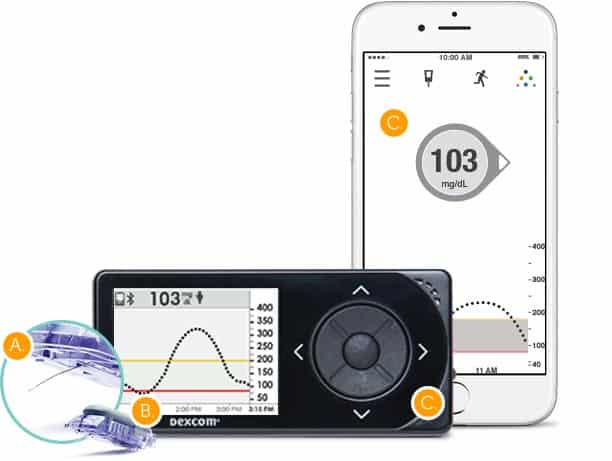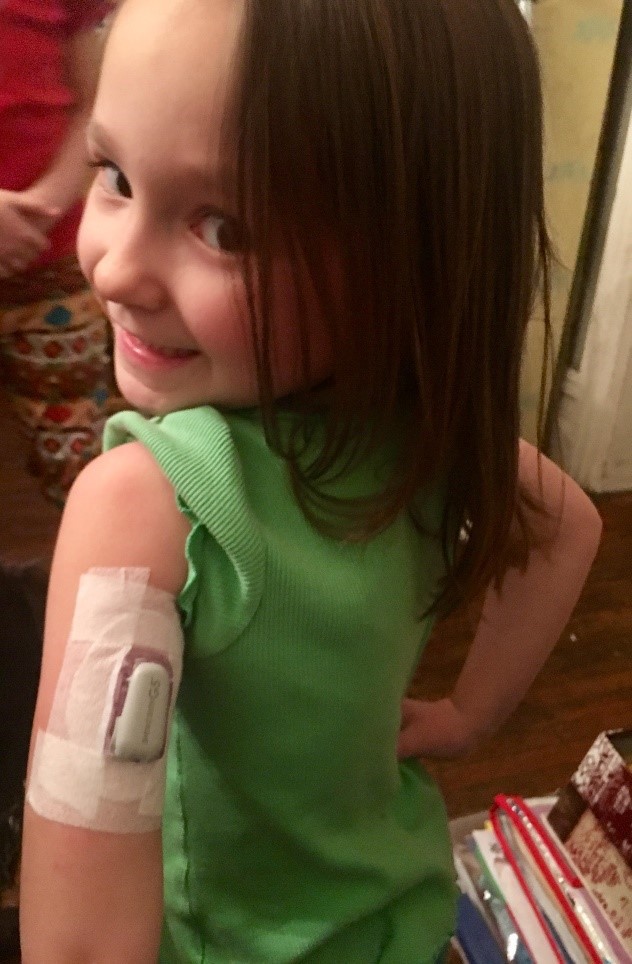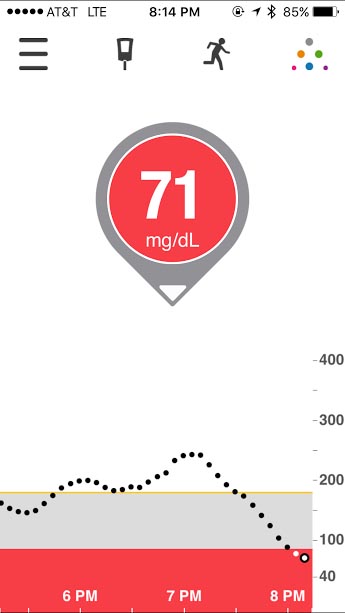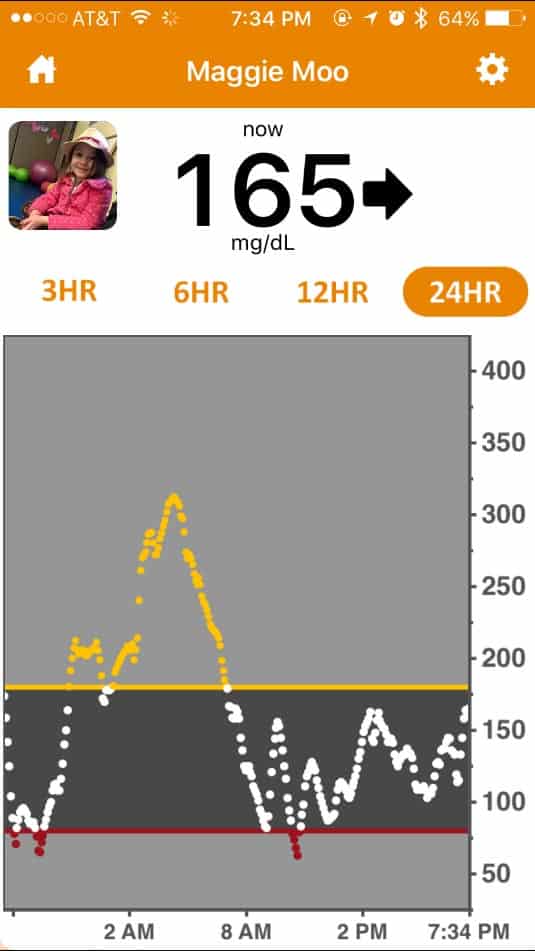
Dexcom has been the leader in the continuous glucose monitoring market for many years. They always seem to be ahead of the game in terms of technology, and the newest addition to the Dexcom family is just that and more.
Their recent release of their G5 system provides users with a variety of features to help make managing your diabetes care much more simple. G5 is the same system as their previous G4 GGM system but it no longer requires a receiver. The transmitter works over a Bluetooth signal which can be picked up by a smartphone with an installed Dexcom application. The phone now acts as the receiver to display all information and alarms.
I suggest reading the following:
Not a lot has changed in terms of the G4 and G5, the sensors are the same, calibrations are still required a minimum of two times a day. The accuracy is still the same as the G4, as well as the trend display settings. So what is the benefit of the G5 over the G4 system? Let’s discuss:
What is the G5 System?

To understand what the G5 system really is you first need to understand that it features four different components to it.
CGM Sensor: The CGM sensor for the G5 system is the same as the G4 Platinum sensor. It is inserted into the skin for up to 7 days. The sensor still requires that you check your blood sugar two times a day to calibrate the system. I can attest that we’ve checked a little more with my youngest who is currently wearing the G5 system. This has helped to improve the overall accuracy of the sensor even more.
G5 Transmitter: The G5 transmitter is equipped with Bluetooth connectivity so that it is able to send blood sugar data every five minutes. It can pair with two devices to give you the option on how to choose to see your data. The receiver, or through your smartphone.
Receiver: The G5 receiver is really just an updated version of the G4 that displays the data along with the use of the application.
iPhone/ iPod Application: Works as your receiver to display real time data and trends. It will alarm with sounds and notifications. Through the use of the Share application, caregivers and parents can keep track of blood sugar data remotely.
Set up of the G5 System
Setting up the system doesn’t take much time at all, it takes around 5 to 10 minutes. You must download the application from the iTunes app store and create your own Dexcom account. Then you will be able to navigate through the set up on screen. Instead of having to enter in the long transmitter number, you just have to take a picture of the serial number to connect it. From there, you are able to pair your transmitter via Bluetooth easily.
Those who have used Dexcom sensors previously understand that once you insert a new sensor it requires a two-hour warmup until you will start to receiver your information.
Pros
- One of the biggest pros for parents of children with Type 1 diabetes is that there is no longer a separate receiver for them to lose. The receiver was small enough to fit in a pocket, which makes it much easier to lose than many smartphones.
- The trend graph is simple to use and view. You can scroll your finger right over the graph to see individual blood sugar numbers.
- Instead of having to be stuck with the typical boring few alert notification beeps, you can now choose from up to 22 different ones such as a crying baby, or police siren.
- For those who had trouble previously viewing the trend graph, you are in luck. It’s much larger now, about four times the size of the G4 system display.
- Calibrating the system doesn’t take as long as it did before. This is because they are now typed in instead of being scrolled in, which takes much less time.
- Because you will be using your smartphone as your receiver display you can set it to stay on for as long or as short as you prefer. If you are an adult PWD that loves to workout, this is nice because you don’t have to keep pressing your screen or buttons to get the display up so that you can see your current level.
- The application that you install on your smartphone comes with its own built-in user guide with video tutorials, direct links to Dexcom and a setup wizard.
Cons
- Compatible with Apple & Android.
Right now the only compatible smartphones are the Apple iPhones. Plans are currently in the works to create an application that can be used with Android phones (available on Android now), but it may be quite some time until this is available. - The transmitter is a little bit thicker than the previous version, this is because of the need for the Bluetooth component.
- The transmitter range for the Bluetooth connectivity seems to be between 5 to 10 feet.
- The newer Bluetooth enabled transmitter has about half of the battery life that the old one did. It only lasts for three months’ time. You will receive a warning before it ends but it won’t go much further than a few days after the warning. The G4, however went much longer. It’s important to remember when the 3-month date is up so that you can ensure you have a new transmitter ordered and delivered in time.
- It’s important to remember to ALWAYS keep your smartphone charged. Because when your phone dies you will no longer have access to the CGM data.
- Another battery downside is that the application seems to deplete your phone battery much faster.
- The phone application also seems to lose its signal quite often throughout the day.
- Costly for people without coverage through their health insurance.
The G5 offers many unique advantages for patients with diabetes. It expands their viewing options for reviewing your real time data. The Dexcom Clarity software is great to review your data in a longer term chart. It can be easily printed right from your phone for your doctor to view.
One downside to having your receiver on your phone is socialization and the workplace. It is considered rude to always be looking at your phone. So what happens when you are in the middle of a meeting and your phone alerts to a low or high blood sugar? Will your coworkers and even your boss thinks you’re being rude to look down at your phone.
Overview of the G5 Application
The G5 application works to communicate using Bluetooth with your transmitter every five minutes to provide you with a trend arrow and graph. The benefit of the trend arrow is that the system works to alert you when you may be going low or going high. This can help to provide you with the ability to correct or treat if necessary to prevent a high blood sugar and a low blood sugar.
The major benefit of using the phone instead of the receiver is quite apparent when you open up your application. The screen display is much larger than that of the receiver. It’s really a big improvement for those who had difficultly viewing the graph information on the receiver.
The trend graph shows a colored circle that corresponds to in-range, low trend, or high trend. The color yellow is a high blood sugar, red a low blood sugar and gray an in-range blood sugar. The arrows then wrap around the circle to show the direction that your blood sugar is going.
Within the Dexcom application you have the ability to manually enter carbohydrate grams, insulin, and exercise. It would be nice to see this feature as an automated process for future integrations.
Overview of the G5 Transmitter
The transmitter has the ability to pair with two devices, your smartphone and the receiver. They can be used separately or together. It is considered to be the hub of the system because it broadcasts the Bluetooth signal for the receiver and phone to pick up. You can enter in your blood sugar calibrations on the application on your phone and your device will update within seconds.
The downside to the transmitter is that it seems that the signal range is shorter than that of the G4. The G4 offered up to a 20ft or more range, but the G5 is only around 5 to 10 feet. It does not have the ability to transmit data through floors in your home.
Dexcom Share
As a parent of a young child with Type 1 diabetes, the Dexcom Share app is everything I’ve been searching for. It gives me the ability to remotely monitor my daughters blood sugar levels when she is not home. So when she’s at school, I can see what she currently is and even look at her trend. The downside to this is that she now has to have her own smartphone at the age of 6. I see a huge benefit for teens and adults with diabetes to not have to use a receiver because they always have their smartphone on them. But for a young child like mine, I’d love to have the receiver be the only device she needs to have on her for me to still use the share application.
Further reading:
Who Could Benefit from the G5?
While most everyone with diabetes could benefit from the use of a continuous glucose monitoring system, there are some that could benefit from the G5 more than others.
- Those who prefer not to have to carry a receiver or those unsure of getting a CGM because they are resistant to having to carry another device on them.
- Active users that don’t like having a receiver on them during periods of exercise.
- Parents and caregivers to loved ones that wish to remotely monitor blood sugar data.
- Those who would like a little more discretion when it comes to their diabetes management.
- Heavy sleepers who have trouble waking up to alarms.
You can order yours on Amazon.
Hope this review helped you make a better deicision.
TheDiabetesCouncil Article | Reviewed by Dr. Jack Isler MD on May 20, 2020







